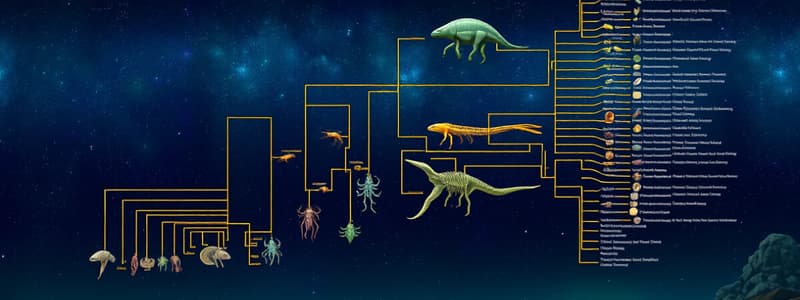Podcast
Questions and Answers
How many organisms on the cladogram have lungs?
How many organisms on the cladogram have lungs?
5
List a characteristic that salamanders and mice share.
List a characteristic that salamanders and mice share.
They both have lungs and jaws.
Name 2 organisms that have fur and mammary glands.
Name 2 organisms that have fur and mammary glands.
Mouse and Chimp
Which organism does not have a jaw?
Which organism does not have a jaw?
List a characteristic that lizards and pigeons both have.
List a characteristic that lizards and pigeons both have.
Which pair of organisms are most closely related?
Which pair of organisms are most closely related?
Name 2 organisms that have amniotic eggs.
Name 2 organisms that have amniotic eggs.
Which animals can molt their exoskeleton?
Which animals can molt their exoskeleton?
Name organisms that have lungs.
Name organisms that have lungs.
Name the 2 organisms with spiny-rayed fins.
Name the 2 organisms with spiny-rayed fins.
Name all the characteristics that lizards and birds share.
Name all the characteristics that lizards and birds share.
Which pair of organisms are most closely related?
Which pair of organisms are most closely related?
How would you explain to someone how to read a cladogram?
How would you explain to someone how to read a cladogram?
Define the Law of Superposition.
Define the Law of Superposition.
Flashcards are hidden until you start studying
Study Notes
Organisms with Lungs
- Five organisms identified to have lungs: Salamander, Lizard, Pigeon, Mouse, Chimp.
- All these organisms are positioned above the "Lungs" line on the cladogram.
Shared Characteristics
- Salamanders and mice both possess lungs and jaws, indicating a shared evolutionary trait.
Mammary Glands
- The mouse and chimp are noted for having fur and mammary glands, highlighting their classification as mammals.
Jawless Organism
- The hagfish is identified as the only organism lacking a jaw, emphasizing the diversity of jaw structures among vertebrates.
Claws and Nails
- Lizards and pigeons are characterized by having either claws or nails, illustrating some anatomical similarities.
Closest Relatives
- The most closely related pair of organisms on the cladogram is the perch and salamander due to their adjacent placement.
Amniotic Eggs
- Organisms that lay amniotic eggs include lizards and birds, a trait that has implications for their reproductive strategies.
Molting Exoskeletons
- Lobsters and spiders are capable of molting their exoskeletons, a crucial process for growth in arthropods.
Organisms with Lungs
- The organisms that have lungs include founder, lungfish, lizards, birds, and mammals, showcasing evolutionary adaptations.
Spiny-rayed Fins
- The perch and flounder are the two species characterized by spiny-rayed fins, relevant for their identification in aquatic systems.
Shared Characteristics of Lizards and Birds
- Lizards and birds share several characteristics: claws, amniotic eggs, lungs, vertebrae, and the ability to see UV light.
Closest Relationship of Lizards and Birds
- Lizards and birds are closely related according to their proximity on the cladogram, suggesting a shared evolutionary lineage.
Reading a Cladogram
- A cladogram can be read by noting that all organisms above a characteristic line share that trait, indicating their evolutionary relationships.
Law of Superposition
- Defines the concept that in layered soil deposits, the younger layers are positioned on top of older layers, providing a framework for understanding geological time.
Studying That Suits You
Use AI to generate personalized quizzes and flashcards to suit your learning preferences.




